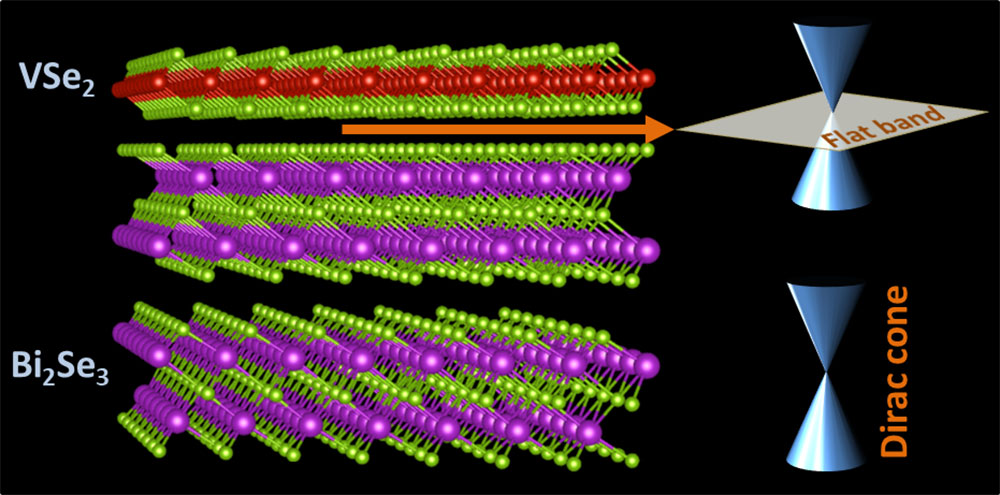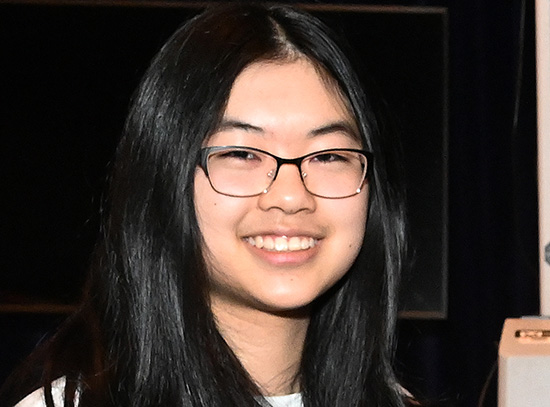Flat Band Structure Observed in Topological Material
This newly discovered structure could be used to boost the onset temperature for superconductivity
June 30, 2021
 enlarge
enlarge
The image shows the vanadium diselenide (VSe2) bismuth selenide (Bi2Se3) heterostructure (left) and a comparison of the electronic structures (right); only through the existence of the interface is the flat band created. Image credit: Brookhaven National Laboratory
The Science
Scientists observed, for the first time, an emergent flat band electronic structure in the vanadium diselenide (VSe2) bismuth selenide (Bi2Se3) heterostructure.
The Impact
Topological materials could be a path to future quantum devices. However, to fully harness their potential, researchers need to understand which materials exhibit a flat band structure that can be controlled for use in devices. This study discovered a flat band structure that could be used to boost the onset temperature for superconductivity.
Summary
Novel quantum computers harness the effects of the inherent emergent phenomena that exist within the material the devices are made of. These quantum phenomena are an integral part of the atomic makeup and physics of these materials. The physics of these phenomena is largely determined by how the electrons are organized within the material. This organization is called the energy band structure. So, to fully understand and control quantum effects in any material, researchers need to investigate the distinct electronic band structure of the material in question. Based on that new understanding, they might be able to engineer specific quantum effects for new quantum computers or high temperature superconductors.
The biggest disadvantage of many superconducting materials, however, is the extremely low temperature that is required to achieve the superconducting state in the first place. Therefore, researchers believe that topological materials are the key to fault tolerant quantum computers due to their immune electronic structure against their surroundings. This means that topological materials could be used to create high-temperature superconductors if their electronic structure can be modified effectively.
In this study, a team of researchers observed, for the first time, an emergent flat band structure in vanadium diselenide (VSe2) Bismuth selenide (Bi2Se3), a topological insulator. This observation opens the pathway for future applications in high-temperature superconductors since the onset temperature of the superconductivity can be boosted by a topological flat band.
After the researchers synthesized their samples of this new material, they used multiple methods to investigate the electronic structure. Among these methods, the researchers used the Angle-Resolved Photoemission Spectroscopy (ARPES) and the X-ray Photoemission Electron Microscopy (XPEEM) experimental stations of the Electron Spectro-Microscopy (ESM) beamline at the National Synchrotron Light Source II (NSLS-II). The ESM beamline is part of a suite of advanced research tools for investigating the electronic structure of materials at NSLS-II. NSLS-II is a U.S. Department of Energy (DOE) Office of Science user facility located at DOE’s Brookhaven National Laboratory. In addition to their studies at NSLS-II, the team also used advanced research capabilities at the Center for Functional Nanomaterials (CFN), another DOE Office of Science user facility located at Brookhaven Lab.
The researchers showed that the flat band structure covers the entire Brillouin zone, the smallest, repeating cell within a crystal structure, and shows a 2D nature. Their findings are the first example of a special electronic structure, called dispersionless electronic excitation, in a topological material. Their results could open a new pathway to experimentally realizing and controlling novel quantum effects.
Download the research summary slide
Contact
Turgut Yilmas
National Synchrotron Light Source II
tyilmaz@bnl.gov
Publications
T. Yilmaz, X. Tong, Z. Dai, J. T. Sadowski, E. F. Schwier, K. Shimada, S. Hwang, K. Kisslinger, K. Kaznatcheev, E. Vescovo, B. Sinkovic. Emergent flat band electronic structure in a VSe2/Bi2Se3 heterostructure. Communications Materials, 2, 11 (2021) DOI: 10.1038/s43246-020-00115-w
Funding
This research used ESM (21-ID-1, 21-ID-2) beamline of the National Synchrotron Light Source II, a US Department of Energy (DOE) Office of Science User Facility operated for the DOE Office of Science by Brookhaven National Laboratory under Contract number DE-SC0012704. This work also used the resources of the Center for Functional Nanomaterials, Brookhaven National Laboratory, which is supported by the U.S. Department of Energy, Office of Basic Energy Sciences, under Contract number DE-SC0012704. ARPES experiments in Hiroshima were performed with the approval of program advisory committee of HISOR) Proposal number 19BG041). T.Y. thanks Professor A.V. Balatsky for useful discussions.
2021-19017 | INT/EXT | Newsroom









